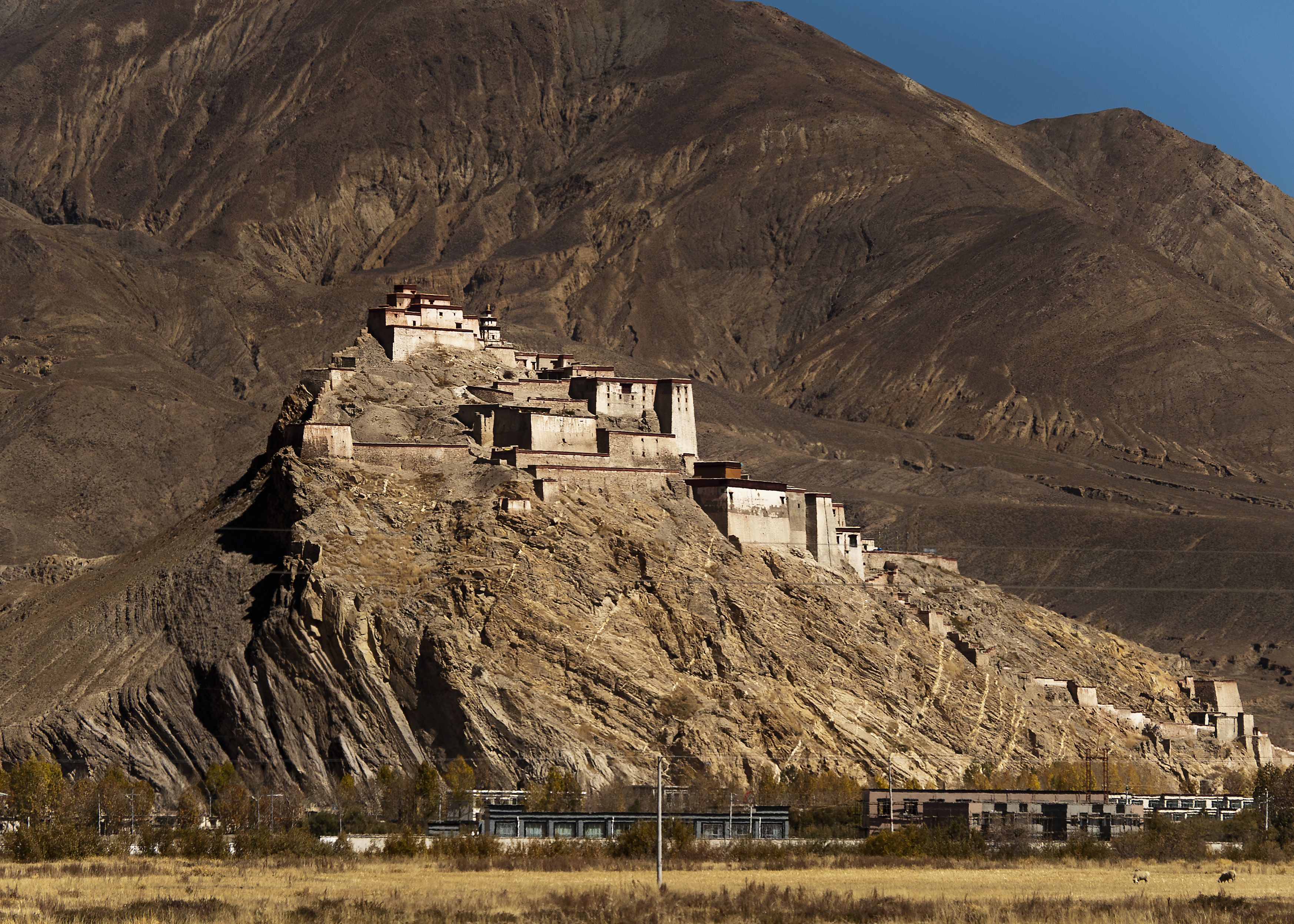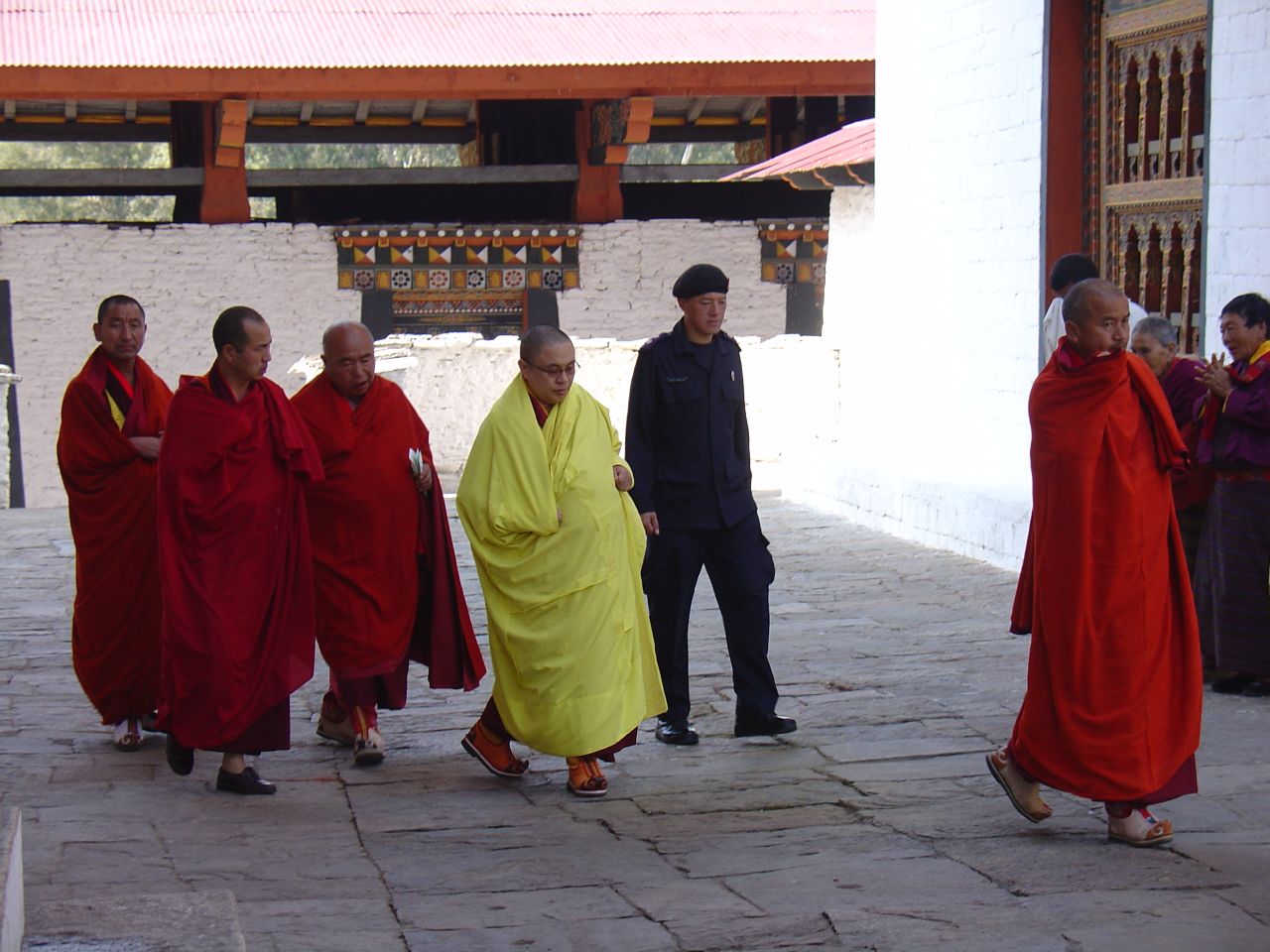|
Tashichho Dzong
Tashichho Dzong () is a Buddhist monastery and fortress on the northern edge of the city of Thimphu in Bhutan Bhutan, officially the Kingdom of Bhutan, is a landlocked country in South Asia, in the Eastern Himalayas between China to the north and northwest and India to the south and southeast. With a population of over 727,145 and a territory of , ..., on the western bank of the Wang Chu. It has traditionally been the seat of the Druk Desi (or "Deb Raja"), the head of Bhutan's civil government, an office which has been combined with the kingship since the creation of the monarchy in 1907, and summer capital of the country. In old British documents, it is known as Tassisudon. According to a 1922 traveller: The main structure of the whitewashed building is two-storied with three-storied towers at each of the four corners topped by triple-tiered golden roofs. There is also a large central tower or ''utse''. History The original Thimphu dzong (the Do-Ngön Dzong, or Bl ... [...More Info...] [...Related Items...] OR: [Wikipedia] [Google] [Baidu] |
Karmapa
The Karmapa Tulku lineage of the Gyalwa Karmapa is the oldest among the major incarnating lineages of Tibetan Buddhism,The Karmapa, "The Karmapas Lineage", Kagyu Office established in 1110 CE by the 1st Karmapa, Düsum Khyenpa. Karmapa means "the one who carries out buddha-activity", or "the embodiment of all the activities of the buddhas". A total of 17 Karmapa manifestations have incarnated after their predecessors predict their own rebirths in detailed letters. Their honorific titles include ''His Holiness the Gyalwa Karmapa'' (, and more formally as ''Gyalwang'' () The Karmapa is the head of the Karma Kagyu, the largest sub-school of the Kagyu school (), itself one of the four major schools of Tibetan Buddhism. The main seat of the four Tibetan seats of the Karmapas is the Tsurphu Monastery in U-Tsang, along the Tolung valley of central Tibet. The Karmapa's seat built during the Tibetan diaspora is the Dharma Chakra Centre at Rumtek Monastery in Sikkim, India. The i ... [...More Info...] [...Related Items...] OR: [Wikipedia] [Google] [Baidu] |
Dzongs In Bhutan
Dzong architecture is used for dzongs, a distinctive type of fortified monastery (, , ) architecture found mainly in Bhutan and Tibet. The architecture is massive in style with towering exterior walls surrounding a complex of courtyards, temples, administrative offices, and monks' accommodation. Characteristics Distinctive features include: * High inward sloping walls of brick and stone painted white with few or no windows in the lower sections of the wall * Use of a surrounding red ochre stripe near the top of the walls, sometimes punctuated by large gold circles * Use of unique style flared roofs atop interior temples * Massive entry doors made of wood and iron * Interior courtyards and temples brightly colored in Buddhist-themed art motifs such as the ashtamangala or swastika Regional differences Bhutan Dzongs serve as the religious, military, administrative, and social centers of their district. They are often the site of an annual '' tsechu'' or religious festival. Typica ... [...More Info...] [...Related Items...] OR: [Wikipedia] [Google] [Baidu] |
Je Khenpo
The Je Khenpo (; "The Chief Abbot of the Central Monastic Body of Bhutan"), formerly called the ''Dharma Raja'' by orientalists, is the title given to the senior religious hierarch of Bhutan. His primary duty is to lead the Dratshang Lhentshog (Commission for the Monastic Affairs) of Bhutan, which oversees the Central Monastic Body, and to arbitrate on matters of doctrine, assisted by ''Five Lopen Rinpoches '' (learned masters). The Je Khenpo is also responsible for many important liturgical and religious duties nationwide. The sitting Je Khenpo is also formally the leader of the southern branch of the Drukpa Kagyu sect, which is part of the Kagyu tradition of Tibetan Buddhism. Aside from the King of Bhutan, only the Je Khenpo may don a saffron kabney. History According to the dual system of government established by Ngawang Namgyal in the 17th century, the powers of the government of Bhutan were ideally split between the religious branch, headed by the Je Khenpo, and ... [...More Info...] [...Related Items...] OR: [Wikipedia] [Google] [Baidu] |
Thongdrel
A thongdrel (མཐོང་གྲོལ།) or throngdrel is a large appliqué (གོས་དྲུབ།) religious image normally only unveiled during '' tsechus(ཚེ་བཅུ།)'', the main religious festivals in Bhutan. They are the largest form of '' thangka(ཐང་ཀ།)'' paintings in the tradition of Tibetan Buddhism. Thongdrels typically depict a seated Guru Rinpoche surrounded by holy beings in a composition that, unlike most smaller thangkas, is in a "landscape" format, somewhat wider than it is tall. Thongdrels are composed of several layers, mostly of silk. These begin with a backing, then the image itself, made up of appliqué pieces sewn to a background. Finally there is a yellow drape that covers and protects it when not on display. Thongdrels are stored rolled up. Thongdrels are displayed once a year as the highlight of the tsechu festival of a district or ''dzongkhag'' (although not every district has a thongdrel). Typically they are displayed ... [...More Info...] [...Related Items...] OR: [Wikipedia] [Google] [Baidu] |
Dechencholing Palace
Dechencholing Palace (, ') is located in Thimphu, the capital of Bhutan, to the north of the Tashichho Dzong and north of the city centre. It was built in 1953 by the third List of rulers of Bhutan, king of Bhutan ''Druk Gyalpo'' Jigme Dorji Wangchuck. Geography The palace lies at the northern end of the Thimphu Valley, on the west bank of the Thimphu River. The palace is accessed via the Dechhen Lam (road) which runs along the eastern bank of the Thimphu river from the district of Yangchenphug, through Langjupakha for several kilometres before approaching the palace. On the way to the palace the road passes the Royal Banquet Hall, the Centre for Bhutan Studies, the Woodcraft Centre and then passes the Indian Estate on the other side of the river. Just south of the palace on the other side of the river is the suburb of Taba. The palace is surrounded by forest to the east and west; the eastern forest is denser and is said to be the only leafy forest in the city. Opposite on a slop ... [...More Info...] [...Related Items...] OR: [Wikipedia] [Google] [Baidu] |
Politics Of Bhutan
The government of Bhutan has been a constitutional monarchy since 18 July 2008. The King of Bhutan is the head of state. The executive power is exercised by the Lhengye Zhungtshog, or council of ministers, headed by the Prime Minister. Legislative power is vested in the bicameral Parliament, both the upper house, National Council, and the lower house, National Assembly. A royal edict issued on April 22, 2007 lifted the previous ban on political parties in anticipation of the National Assembly elections in the following year. In 2008, Bhutan adopted its first modern Constitution, codifying the institutions of government and the legal framework for a democratic multi-party system. Sovereignty Bhutanese external relations and foreign policies were put under British control following the 1910 Treaty of Punakha. However, due to the policy of self-imposed isolationism, the effect of the treaty was limited to an extent. After Indian independence in 1949, Bhutan and India agreed to a ... [...More Info...] [...Related Items...] OR: [Wikipedia] [Google] [Baidu] |
Rangjung Rigpe Dorje
The 16th Karmapa, Rangjung Rigpe Dorje (; August 14, 1924 – November 5, 1981) is the 16th Gyalwa Karmapa and the spiritual leader of the Karma Kagyu lineage of Tibetan Buddhism. He is of the oldest line of Tulku, reincarnate lamas in Vajrayana, Vajrayana Buddhism, known as the Karmapas whose coming was predicted by the Gautama Buddha, Buddha in the Samadhiraja Sutra#In the Kagyu lineage, Samadhiraja Sutra. The 16th Karmapa was considered to be a "living Buddha" and was deeply involved in the transmission of Tibetan Vajrayana Buddhism to Europe and North America following the Annexation of Tibet by the People's Republic of China, Chinese invasion of Tibet. He was known as the "King of the Yogis", and is the subject of numerous books and films. Biography Birth The 16th Karmapa was born in Denkhok in the Kingdom of Derge in Kham eastern Tibet near the Yangtze River, Dri Chu River (Ch. Yangtze). The previous Karmapa Khakyab Dorje (1871-1922) left a letter setting forth the circums ... [...More Info...] [...Related Items...] OR: [Wikipedia] [Google] [Baidu] |
Jigme Dorji Wangchuck
Jigme Dorji Wangchuck (, ; 2 May 1928 – 21 July 1972) was the 3rd Druk Gyalpo of Bhutan. He began to open Bhutan to the outside world, began modernization, and took the first step towards democratization. Early life Jigme Dorji Wangchuck was born in 1928 in Thruepang Palace in Trongsa. At a young age, he was apprenticed in etiquette and leadership at the royal court of his father the King. Wangchuck was educated in a British manner in Kalimpong and Bishop Cotton School, Simla and he went on study tours to many foreign countries such as Scotland and Switzerland from where he drew inspiration to develop Bhutan with suitable adaptations. In 1943, he was appointed Trongsa '' Dronyer'' and then elevated as the 25th Paro '' Penlop'' in 1950, upon the death of the 24th Paro ''Penlop'', Tshering Penjor (1902–1949). Wangchuck married ''Ashi'' Kesang Choden Wangchuck (born 1930), the daughter of '' Gongzim'' (Lord Chamberlain) Sonam Topgay Dorji (1896–1953), at the Ugyen Pelr ... [...More Info...] [...Related Items...] OR: [Wikipedia] [Google] [Baidu] |
Monastery
A monastery is a building or complex of buildings comprising the domestic quarters and workplaces of Monasticism, monastics, monks or nuns, whether living in Cenobitic monasticism, communities or alone (hermits). A monastery generally includes a place reserved for prayer which may be a chapel, Church (building), church, or temple, and may also serve as an Oratory (worship), oratory, or in the case of Cenobium, communities anything from a single building housing only one senior and two or three junior monks or nuns, to vast complexes and estates housing tens or hundreds. A monastery complex typically comprises a number of buildings which include a church, dormitory, cloister, refectory, library, Wiktionary:balneary, balneary and Hospital, infirmary and outlying Monastic grange, granges. Depending on the location, the monastic order and the occupation of its inhabitants, the complex may also include a wide range of buildings that facilitate self-sufficiency and service to the commun ... [...More Info...] [...Related Items...] OR: [Wikipedia] [Google] [Baidu] |
Shabdrung Ngawang Namgyal
Ngawang Namgyal (; alternate spellings include ''Zhabdrung Ngawang Namgyel;'' 1594–1651), known colloquially as ''The Bearded Lama'', was a Tibetan Buddhist Drukpa Kagyu school Rinpoche, and the unifier of Bhutan as a nation-state. He was later granted the honorific title Zhabdrung Rinpoche, approximately "at whose feet one submits". In addition to unifying the various warring fiefdoms for the first time in the 1630s, he also sought to create a distinct Bhutanese cultural identity separate from the Tibetan culture from which it was derived. Birth and enthronement at Ralung ''Zhabdrung'' Ngawang Namgyal was born at Ralung () Monastery, Tibet as the son of the Drukpa Kagyu lineage-holder Mipham Tenpa'i Nyima (, 1567–1619), and Sönam Pelgyi Butri (), daughter of the local king of Kyishö () in Tibet. On his father's side, Ngawang Namgyal descended from the family line of Tsangpa Gyare (1161–1211), the founder of the Drukpa Lineage. In his youth, Ngawang Namgyal was ent ... [...More Info...] [...Related Items...] OR: [Wikipedia] [Google] [Baidu] |


